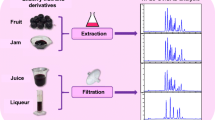Abstract
Seven commercial metatartaric acid (MTA) products used for tartaric stabilization of wines were investigated regarding molecular masses and composition. Combined size-exclusion chromatography with MALS detection showed that the products had medium molecular masses in a range of 2–9 kDa. All samples were highly polydisperse products with a broad molecular weight distribution. Beside oligomeric or polymeric contents, the products contained on average 13 g/100 g monomeric tartaric acid, thus reducing the effectiveness of MTA in respect of achieving tartaric stability. An analytical method to determine MTA in wines and grape juices based on an anion-exchange cleanup step, HPLC separation, and MS detection was developed. The method shows a sufficient robustness to evaluate important enological or food legal aspects in connection with MTA.






Similar content being viewed by others
References
Pilone BF, Berg HW (1965) Some factors affecting tartrate stability in wine. Am. J. Enol. Vitic. 16:195–211
Rhein O, Neradt F (1979) Tartrate stabilization by the contact process. Am. J. Enol. Vitic. 30:265–271
Patrícia AMH, Soares VC, Fernandes C, Cameira dos Santos P, de Pinho MN (2009) Wine tartaric stabilization by electrodialysis: prediction of required deionization degree. Am. J. Enol. Vitic. 60:183–188
Bories A, Sire Y, Bouissou D, Goulesque S, Moutounet M, Bonneaud D, Lutin F (2011) Environmental impacts of tartaric stabilisation processes for wines using electrodialysis and cold treatment. S. Afr. J. Enol. Vitic. 32:174–182
Marchal R, Jeandet P (2009) In: Moreno-Arribas MV, Polo MC (eds) Wine chemistry and biochemistry. Springer Science Business, New York
Moine-Ledoux V, Perrin A, Paladin I, Dubourdieu D (1997) Premiers résultats de stabilisation tartrique des vins par addition de mannoprotéines purifiées (Mannostab). J. Int. des Sci. de la Vigne et du Vin 31:23–31
Caridi A (2006) Enological functions of parietal yeast mannoproteins. Antonie Van Leeuwenhoek 89(3–4):417–422
EC Commission Regulation (606/2009) Annex IA #27. Off. J. Eur. Comm.
Ribéreau-Gayon P, Glories Y, Maujean A, Dubourdieu D (2000) Handbook of enology volume 2, the chemistry of wine: stabilization and treatments. Wiley, New York
International Organization of Vine and Wine (OIV, Paris), resolution 10/2007
Acknowledgments
We gratefully acknowledge the Forschungsring Deutscher Weinbau (Research Group German Viticulture, reference number 8503.093/4) for funding. In addition, the authors are grateful to the GfL Berlin for assistance.
Author information
Authors and Affiliations
Corresponding author
Ethics declarations
Conflict of interest
None.
Compliance with Ethic Requirements
This article does not contain any studies with human or animal subjects.
Rights and permissions
About this article
Cite this article
Sprenger, S., Hirn, S., Dietrich, H. et al. Metatartaric acid: physicochemical characterization and analytical detection in wines and grape juices. Eur Food Res Technol 241, 785–791 (2015). https://doi.org/10.1007/s00217-015-2503-1
Received:
Revised:
Accepted:
Published:
Issue Date:
DOI: https://doi.org/10.1007/s00217-015-2503-1



